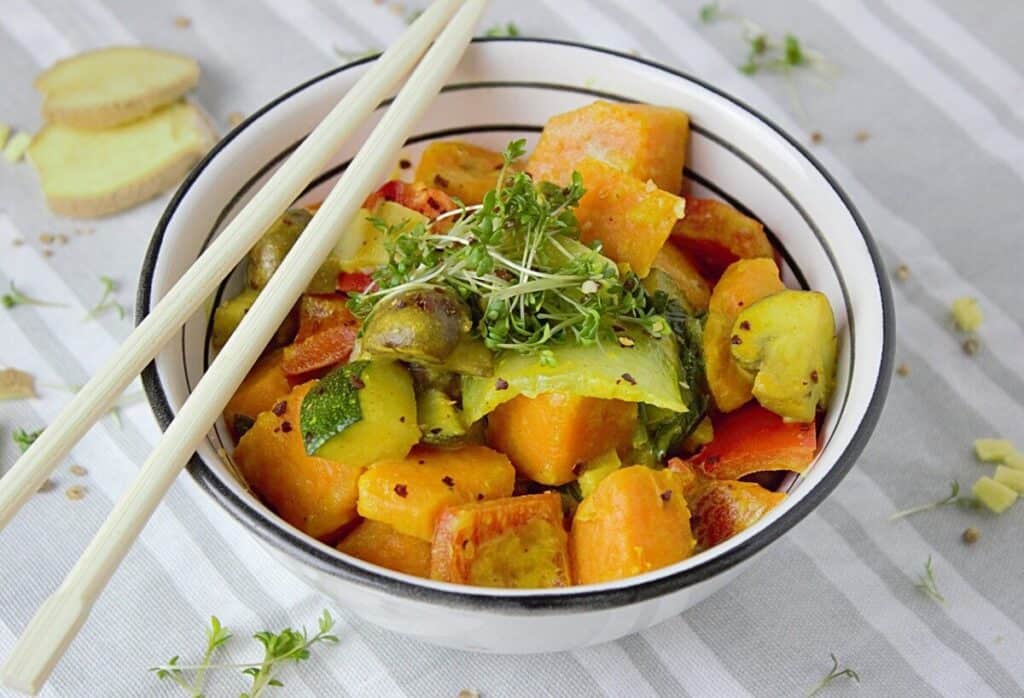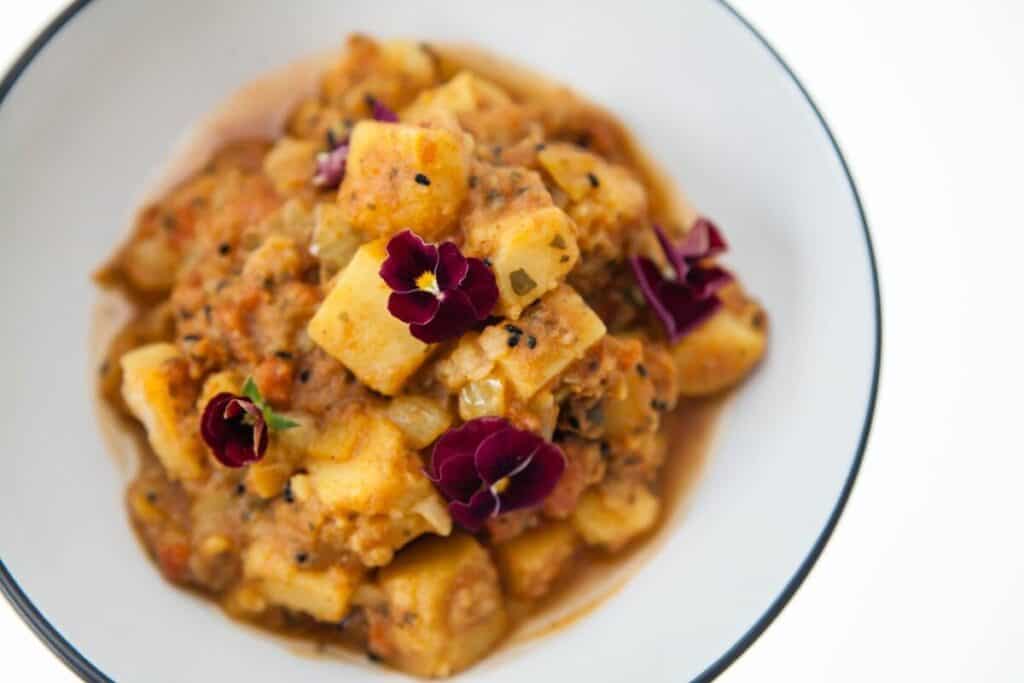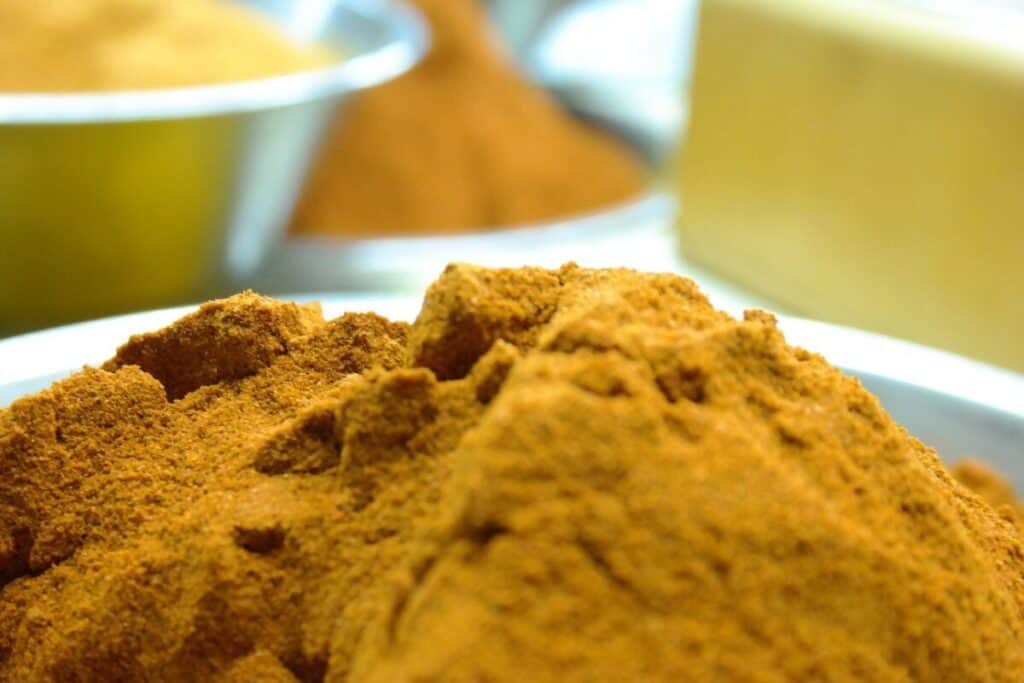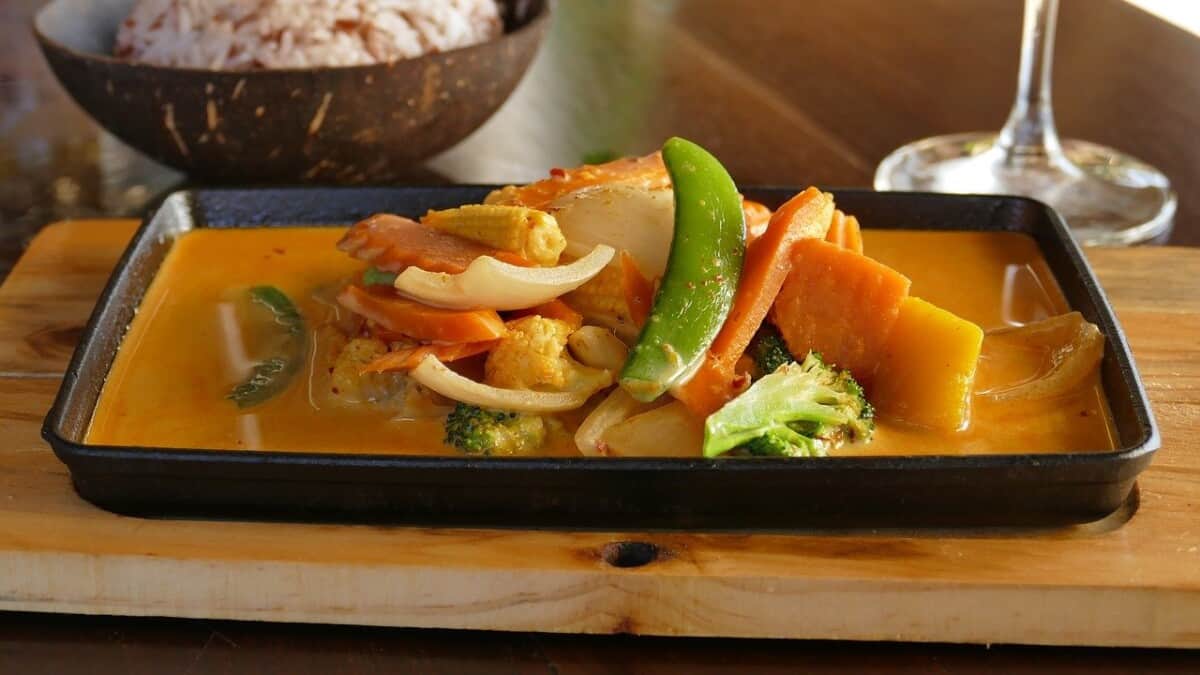The yellow curry is one of the most well-known curry options you will find in Asian cuisine restaurants across the globe. Despite being a fairly common way of making curry even in other countries, the taste varies significantly with the change in locally available ingredients and spices.
The authentic Thai Yellow Curry is made using turmeric, Fenugreek, salt, garlic, coriander, cumin, lemongrass, bay leaf, cayenne pepper, mace, ginger and cinnamon. While the Chinese Yellow Curry is very mild and starchy, the Indian Yellow curry is spicy, flavorful and smooth.
The Yellow curry is famous in the Western World thanks to its aroma rich, spicy, lemon flavor. This delicious curry can be made using several different ingredients. Among the vegetarian options, the Yellow Curry has a mix of spices, multiple vegetables, herbs and coconut milk.
There is no hard and fast rule of which vegetables are to be used while making this. You can use any vegetables like – carrots, peas, baby corn, red bell peppers, mushrooms, potatoes, Eggplant, broccoli, etc. depending on what’s available in your pantry at the moment.
Thai Yellow Curry
We have mentioned the list of ingredients needed to prepare curry sufficient to serve 4 people. Adjust your rations proportionally depending on how many people you are planning to cook for. Let’s talk about the three different cooking styles. Unlike other countries, all the curry recipes in Thailand can be categorized into three main types, the most flavor rich of them being the Yellow Curry.
The Thai curry is made using herbs such as Galangal, Lemon Grass Stalks, Kaffir lime leaves, Thai basil leaves, etc. So, to not compromise on the taste front, it is extremely important to use these exact ingredients mentioned above.
Although some of these supplies are easily available to your local Thai restaurants, it is very difficult for you to acquire them if you are trying to replicate the recipe at home. This gave rise to the Indian and Chinese versions of the yellow curry, which used alternative ingredients to substitute a few of these native Thai herbs and even some spices.
Things like ginger and lemon zest are added to substitute them, hence they greatly influence the final taste and flavor of the curry. But in all three recipes, you first prepare a yellow curry paste and then add the vegetables, coconut milk and so on. The yellow color of the curry arises addition of Turmeric into the paste.
Ingredients
- 1 small cup of medium chopped carrots
- About 9 to 10 chopped baby corn
- 4 to 5 diced mushrooms (preferably button mushrooms)
- 1 medium-sized red bell pepper – fine diced
- About 8 to 10 eggplants (Thai aubergines/eggplants if available)
- 250 ml of coconut milk
- 1 teaspoon of organic sugar
- About half a liter of vegetable stock
- 1 tablespoon of finely chopped Thai Basil
- 2 to 3 teaspoons of soya sauce (can be a mix of light and dark soy sauce)
- 2 tablespoons of coconut oil, Vegetable oil or sunflower oil
- 6-7 Thai Basil leaves to be used for garnishing
- A pinch of salt
- 1 onion or a couple of small shallots – finely chopped
- 2 teaspoons of coriander powder
- 2 teaspoons of cumin seeds or cumin powder
- ¼ teaspoon of black pepper
- 1 teaspoon of turmeric powder
- 2 freshly chopped Thai red chilies
- ½ an inch of Galangal (use normal ginger if unavailable)
- 3 to 4 cloves of garlic (finely chopped)
- 2-3 medium Kaffir lime leaves, finely chopped (use lemon zest if unavailable)
- 1 stalk of lemongrass, chopped (optional)
- ½ teaspoon of lemon zest (optional)
Instructions to Make the Thai Yellow Curry
- The first and foremost step is to prepare the Thai Yellow paste. Add the following ingredients into a blender to make a fine paste – 2 tablespoons of coconut milk, chopped onions, cumin powder, coriander powder, black pepper, turmeric powder, Thai red chilies, Galangal, garlic, lime leaves, lemongrass stalk and lemon zest. For the quantities, to be added, refer to the list of the ingredients.
- Blend all the aforementioned ingredients into a smooth paste with uniform consistency. If you see bits of garlic, Galangal, or even lemon grass still floating around, blend the mixture again. Now extract the curry paste from the blender and keep it aside in a bowl.
- Preheat a pot, pan or wok with the oil. After the oil is hot enough, add the paste you prepared to the pan. Sautee the contents of the pan in the oil for a couple of minutes. Cook until the raw smell is replaced by an aromatic smell.
- Now add about half a cup of the coconut milk (around 150 ml) into the pan, along with the paste, and now sauté for another 2-3 minutes. Allow the paste to blend well with the coconut milk.
- Add the assortment of mixed vegetables you have chopped, into the pan. Our choice of vegetables were carrots, baby corn, button mushrooms, red bell pepper and eggplants. Other notable suggestions are green peas and potatoes, which also go well in the yellow curry. Most restaurant kitchens in the United Kingdom use peas in a yellow curry for flavor and potatoes for sustenance. You can also add other vegetables of your choice.
- Add the water or vegetable stock into the pan and stir. Keep stirring for a few minutes till the curry starts to just boil. Then add the salt and sugar, give the entire curry and a good couple of stirs, and then cover the pan.
- Simmer the vegetables till they are almost cooked, and then add the remaining coconut milk left in the cup (the remaining milk is about 100 ml in quantity).
- Stir the milk properly, and add soya sauce into the pan. Cover the pan again with a lid and cook for about 5 more minutes.
- Now open the lid, and add the basil leaves. If you can’t get hold of Authentic Thai Basil leaves, a viable alternative to consider is Italian Basil leaves. Cook for half a minute and then turn off the stove and stop heating the curry. In the end, garnish the curry on top with some of those basil leaves you kept aside.
- Your Thai Yellow Curry is ready to be served along with some steamed white rice or any mildly flavored rice.

Chinese Yellow Curry
Chinese Yellow Curry is much thinner, soup-like and milder in flavor than Thai or Indian curries. They sometimes use corn starch or Xanthan gum if needed to make it thicker. Xanthan gum is the healthier option of the two, due to its lower carbohydrate content.
The key highlight of the Chinese Yellow Curry is the use of spices, but more specifically, the quantity used. They just use a pinch of turmeric powder and curry powder, while these two are the most significant ingredients in Indian Yellow curry.
Other ingredients like coriander powder, garlic and ginger, remain the same. The quantities mentioned below are to prepare the curry sufficient for about 4 people.
Ingredients
- 5-6 potatoes, peeled, soaked and diced into cubes
- A small cup of frozen peas
- 2 teaspoons of corn flour
- 1 small onion or spring onion or shallots finely chopped
- 2 tablespoons of coconut oil, or rapeseed oil (if unavailable use any Vegetable oil)
- 5-6 finely chopped garlic cloves
- 2 teaspoons of curry powder
- 1 teaspoon of turmeric powder or freshly ground turmeric
- 1 teaspoon of Coriander powder
- ½ teaspoon of salt
- ½ teaspoon of ginger, grounded or finely chopped
- Half a liter of vegetable stock or water
- 1 teaspoon of soy sauce (both dark and light soy sauce)
- 1 teaspoon of oyster sauce
Instructions to Make the Chinese Yellow Curry
- Boil the potatoes in water for a couple of minutes until they are soft.
- Peel the potatoes and then dice them into bite-sized cubes. Toss the potatoes in the corn flour and season them well. Set the corn flour coated potatoes aside for now. Use just the right amount of corn flour to coat them.
- Finely grate the onion and fry the onions in a pan using half of the oil. Use medium heat for around 5 to 6 minutes till the onion starts to sweat.
- Then add garlic and cook the onion and garlic for a minute.
- Add the coriander powder, turmeric powder, salt, ginger and curry powder into the pan and stir the mixture for a couple of minutes.
- Add the vegetable stock (water used to boil the potatoes is also sufficient, if clean). Alternatively, just add plain water cook under low flame for about 10 minutes. Then add the soya sauce and stir, and simmer and cook for another 10 minutes.
- Pour the contents of the pan into a blender and blend it till it forms a smooth, uniform sauce.
- Use the same pan to fry the cubes of potato and the green peas. Pour the remaining oil into the pan and fry the green peas and potatoes till the potatoes turn golden brown. Add a little water if needed.
- Immediately after they are fried, add the sauce you blended into the pan again, and now stir for a couple of minutes with the flame off.
- This curry is a little runny. If you prefer a slightly thicker curry, you can add corn starch or xanthan gum.
- Now that the curry is ready, you can either serve it along with some steamed rice or even a bowl of noodles.

Indian Yellow Curry
Unlike many other Indian foods, Indian Yellow curry is not so spicy, when compared to its Thai counterpart. It is generally less spicy and less oily than many other curries in this cuisine. They are often thicker in consistency than both Chinese and Thai Yellow Curries and Indians generally use tomatoes as natural thickeners in their curries.
Sometimes, Thai kitchens or even western kitchens use corn starch to thicken the sauce. The key highlight of this Indian Yellow Curry is either Toor Dal (split pigeon peas) or an onion-tomato base with turmeric.
Ingredients: (Using Spilt Pigeon peas)
- Vegetable oil – 2tbsp
- Finely chopped ginger – 1 tsp
- Finely chopped garlic – 1 tsp
- Mustard seeds – ½ tsp
- Cumin seeds – ½ tsp
- Red chili (dry) – 2
- Finely chopped onion – 1 large
- Finely chopped tomato – 1 medium
- Cooked split pigeon peas – 2 cups
- Salt – as per taste
- Turmeric powder – ½ tsp
- Red chili powder – a pinch
- Garam masala – ½ tsp
- Curry leaves and coriander leaves to garnish
Instructions to Make the Indian Yellow Curry
- Wash and rinse the split pigeon peas and boil to cook until soft and mushy. You should cook it in a pressure cooker as it is more efficient.
- Take a pan or skillet and add in the oil.
- Next, add the mustard and cumin seeds and allow them to splutter. Then add the red chilies.
- Once the mixture turns fragrant, add the chopped onion, salt and turmeric powder. Sauté and simmer until cooked well and translucent.
- Add in the chopped tomatoes, garam masala, chili powder. Cover and cook until the tomatoes are soft and mushy.
- Next, add the cooked split pigeon peas. Cook for a few minutes. Adjust the salt and other spices.
- Add water if the curry is too thick. Mix well and allow it to stabilize.
- Garnish with curry leaves and coriander.
This curry goes well with Indian Flat Bread like chapati, roti, naan, etc., as well as steamed white rice, or mildly flavored rice (ghee rice, jeera rice, etc.)
Ingredients to Make the Yellow Indian Curry (Using the Onion – Tomato base)
- Vegetable oil – 2 tsp
- Finely chopped ginger – 1 tsp
- Finely chopped garlic – 1 tsp
- Finely chopped chilies – 2
- Cashews – 8-10 (If unavailable, you can use pumpkin seeds)
- Cumin seeds – 1 tsp
- Bay leaf – 1
- Cinnamon stick – 1 inch
- Turmeric powder – ½ tsp
- Salt – as per taste
- Garam masala – ½ tsp
- Red chili powder – ½ tsp
- Dried and crushed fenugreek leaves – a few
- Fresh cream – 2 tsp
- Vegetables of your choice
- Paneer or cottage cheese (optional)
Instructions to Prepare the Indian Yellow Curry (Using the Onion – Tomato Base)
- Add the oil in a pan or skillet. After the oil is hot enough, add the cumin seeds and allow it to splutter.
- Next, add the finely chopped ginger, garlic, chili, bay leaf and sauté until the raw smell is gone.
- Then add the onion, cinnamon stick (you can also add cinnamon powder), salt, turmeric and allow the onion to turn translucent.
- Next add in the cashews or pumpkin seeds, tomatoes, salt, garam masala, red chili powder and cook until soft and mushy. Adjust the salt as per taste.
- After it is cooked, allow this mixture to cool. You can place the pan in ice-cold water to speed up this process. Then grind the mixture to get a smooth, creamy paste. Do not add water here as they gravy becomes runny.
- Take a pan, add some oil, and pour this creamy yellow mixture into it. Cook until the gravy starts leaving the sides. Then add some water and mix well to get a smooth, rich gravy.
- In another pan, add some cubed, vegetables of your choice. Boil all the vegetables well.
- Another way you can do this is, add oil to a pan or skillet as mentioned in step 6. Add in the cubed vegetables of your choice and sauté well until all the vegetables are cooked well. Add some salt as the vegetables can incorporate it while being cooked. Once the vegetables are cooked well but not too tender (they might become mushy), add the ground mixture to the pan.
- Mix the gravy and cooked vegetables. Cover and cook for about 5-10 minutes so that the flavors of the gravy are incorporated in the vegetables.
- Then add some fresh cream and mix well.
- Sprinkle some dried and crushed fenugreek leaves and stir well. Garnish with a sprig of coriander.
Some of the vegetables that you can use are carrot, capsicum, beans, cauliflower, brinjal or eggplant, paneer or cottage cheese, peas, potato, mixed vegetables, etc.
This Indian Yellow Curry can be served with either steamed white rice or mildly flavored rice (ghee rice, jeera rice, etc.) or Indian flatbread such as roti, chapati, poori, tandoori naan, etc.
The specialty of the Indian yellow curry is very versatile in terms of vegetables, dairy products (cottage cheese) used as well as serving options.
If you have decided to try out vegetarian options as your go-to sides, then the Asian Yellow Curry is a good pick. It is rich in flavor and texture. The vegetables make it all the more nutritious.
Most importantly, it is very easy to prepare with simple ingredients that are pantry friendly. The Yellow Curry is also wholesome and makes a great vegetarian meal either with Bread, Rice or noodles.


